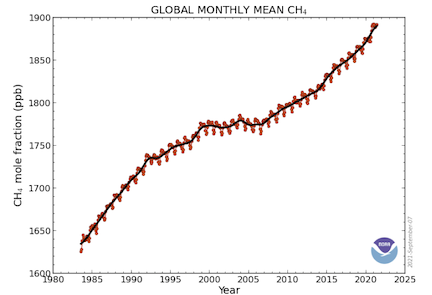Climate Change, Cow Burps, and ZELP
Last month the UN’s Intergovernmental Panel on Climate Change (IPCC) published its latest report which made clear that temperatures today are higher than any time in the last 125,000 years, and methane emissions are a primary culprit.
While methane makes up a smaller share of overall greenhouse emissions compared with carbon dioxide, some estimates indicate it’s close to 80x more powerful than CO2 when it comes to warming the planet.
Unfortunately, atmospheric methane concentrations continue to climb:

When you look at where all that methane is coming from, the livestock industry emerges as one of the largest contributors.
And among livestock, the world’s 1.6 billion cattle are responsible for the majority of the livestock industry’s greenhouse gas emissions.
While plant-based milks and vegetarian beef alternatives are on the rise, so are beef and dairy consumption — projections by the Food and Agriculture Organization of the United Nations show significant growth in the demand for livestock products through 2050.
With that in mind, solutions aimed at mitigating methane emissions stand to have a meaningful impact on climate.
That’s why we recently got behind a team of animal scientists, engineers, product designers, and veterinarians called ZELP (Zero Emissions Livestock Project).
As its name suggests, it’s on a mission to drastically lower greenhouse gas emissions across the livestock industry. It’s developed an unobtrusive wearable for cattle that measures, captures, and oxidizes up to 60% of methane emissions from the mouth and nostrils of cows, which is where they emit nearly all of their methane.
In addition to neutralizing emissions, ZELP can also tell cattle farmers quite a bit about the welfare of their livestock by capturing and analyzing lots of data about their feeding habits, rumination, and rest, which are useful inputs in caring for the health of each animal and help boost farm productivity.
You can follow ZELP’s journey here.